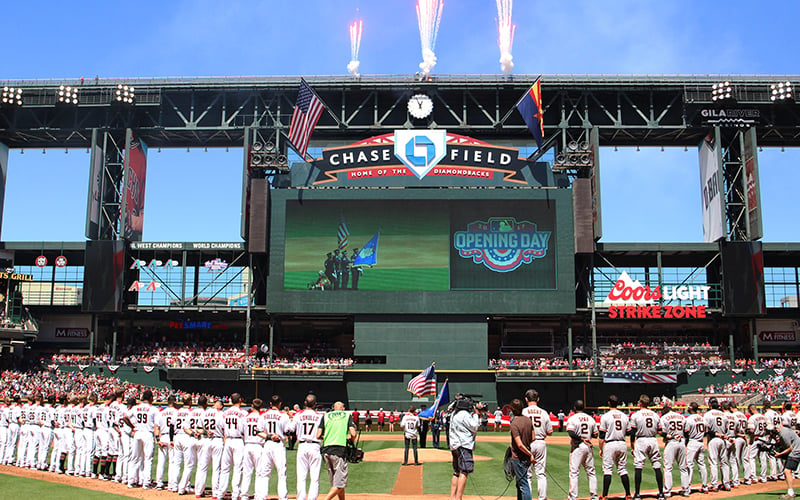PHOENIX — Just as some fans were elated and others were disappointed when Major League Baseball announced three rule changes to take effect next season, Diamondbacks players had similar mixed reactions.
Beginning on Opening Day 2023, bases will be larger, a pitch clock added and the defensive shift banned.
The vote was not unanimous however, as the Major League Baseball Players Association said players had voted against the pitch clock and infield shift rules because the league was “unwilling to meaningfully address the areas of concern that the players raised.”
MLB hopes the new rule changes will speed up the game. The average length of MLB games is three hours and 10 minutes, according to Baseball Reference.
The pitch clock has already taken effect in the minor leagues, and MLB says the pitch timer has reduced the average nine inning game time by 26 minutes, improving the competition. Testing officially began for the new rules in the minors at the start of the 2022 season.
“I got to experience it a little bit,” Diamondbacks pitcher Zach Davies said. “I wasn’t a huge fan of it, I know that there’s people out there that take a lot of time, but for a guy like me who throws four or five different pitches to all different places on the plate, it’s going to be a difficult thing to manage when there is only 15 seconds or however long there is.”
In its most recent week of play, the minor leagues averaged 0.45 pitch timer violations per game, and under the new rule, the pitcher must begin his motion before the expiration of the 15-second timer when the bases are empty and 20 seconds when there’s at least one runner on base.
The testing in the minors recorded 14 seconds with the bases empty and 18 seconds with a runner on base (19 seconds in Triple-A).
Ideally, the faster pace of play will provide better communication between pitchers and umpires, along with limiting batters’ timeouts at the plate. A hitter will now only receive one timeout per plate appearance.
However, for Diamondbacks pitcher Ryne Nelson, who was brought up to the majors on Sept. 5, the rules will remain almost the same for him as they were in Triple-A.
“I’m definitely used to them, I think it’s nice not having the pitch clock, but I understand it and I get where they (MLB) are coming from with that,” Nelson said.
Although newer players to the league are used to the new rule changes, veterans haven’t had to play with the rules in many years, proving it to be a possible challenge next season.
Another rule change for the 2023 season is larger bases. Currently, the bases in the majors are 15 inches square and will be increased to 18 inches square. The goal is to increase player safety and decrease the number of sliding injuries into the bag.
MLB believes the bigger bases will have a positive impact on overall player health and will keep players on the field, reducing time on the injured list.
Diamondbacks outfielder Cooper Hummel hopes MLB addresses the concern of whether the bases will be flat or raised and the shape of the base.
“The smaller bases that we have right now are more, I’m going to say domelike, or moundlike, and it’s easier for guys to hit ’em and turn, and when you hit the bases, guys don’t get hurt as often,” Hummel said. “We had a bunch of guys get hurt when they hit the base in (Triple-A) Nashville ‘cause they were a lot flatter than the ones they used when I went over to Reno.
“So hopefully they make a change there so guys don’t get hurt when it’s flat. It’s going to be an issue with hamstrings and quads and no one wants that.”
Base-related injuries decreased by 13.5% in the minors this season, but also included declines at every level.
“Last season we had bigger bases in the minors,” Diamondbacks outfielder Jake McCarthy said. “If it makes the base path a little shorter and gives us a little edge, for sure that’s part of my game so hopefully it does help.”
The distance between the bases will be decreased by 4.5 inches between first and second and second and third base, which will encourage players to attempt to steal bases more frequently.
The most controversial rule was the ban of the defensive shift.
Starting next season, two infielders must be positioned on each side of second base when a pitch is released and all four infielders must have both feet within the outer area of the infield when the pitcher has both feet on the rubber.
Gone are the days of infielders switching sides with the shift; infielders next season may not switch sides unless there is a substitution happening.
“I’m curious how it’s going to work, how it’s worked at different levels,” Hummel said. “But there’s still going to be different types of shifts, they’re always going to figure out a way around it.”
With the rule changes, MLB hopes that pace of play will improve and increase action throughout the league. With the minor leagues already showing that the rule changes have made a positive impact, the majors hope that the rules will have a similar effect.

